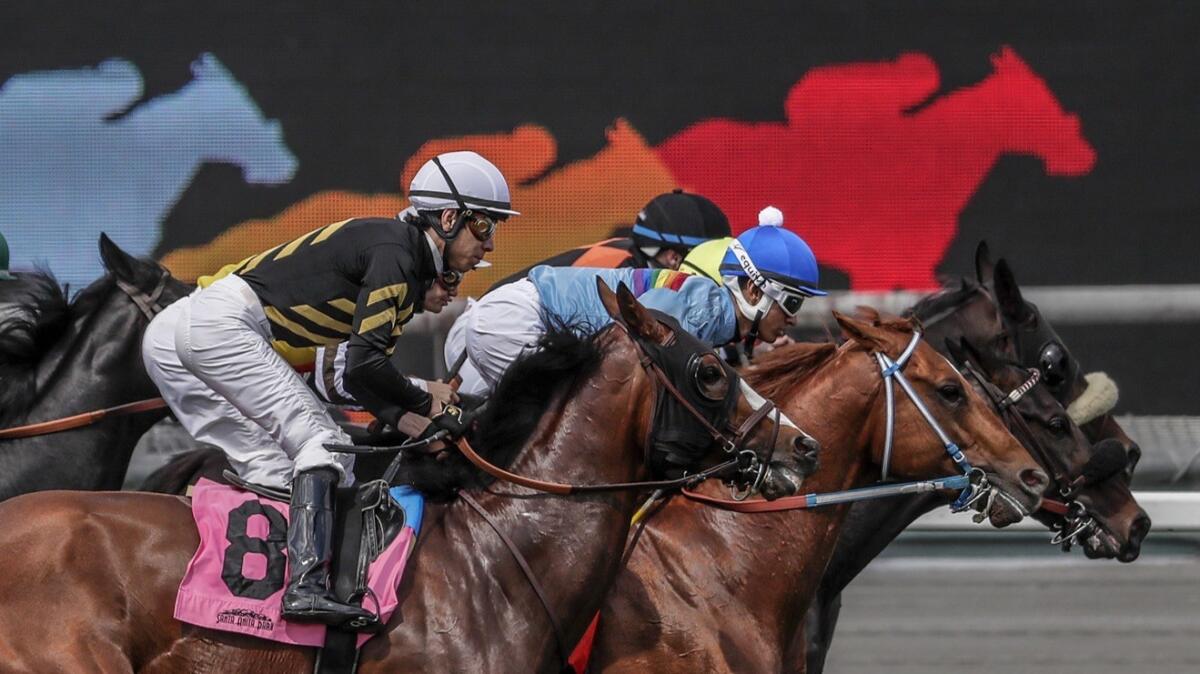Another horse dies at Santa Anita; 26 thoroughbreds have died at the track since Dec. 26

- Share via
A third horse died in nine days at Santa Anita when Kochees could not be saved by surgery Sunday morning after sustaining an injury Saturday during the sixth race.
He was vanned off the course, and a splint was applied. He stayed overnight in his stall with the hope his condition could be stabilized. Because the injury to his left front leg was not a compound fracture, surgery was an option. It would have ended his career but saved his life. However, when surgeons discovered the horse had lost blood flow to the leg, the decision was made to euthanize.
Kochees, a 9-year-old gelding, was running in his 49th race, a $10,000 claiming race over 5 1/2 furlongs. He was pulled up by jockey Mario Gutierrez while leaving the far turn and entering the top of the stretch. His career started Jan. 4, 2013, at Santa Anita, and he had won 11 races.
It was the 26th death at Santa Anita in either racing or training since the meeting opened Dec. 26. It was the third horse death for trainer Jerry Hollendorfer.
The Hall of Fame trainer had the first death Dec. 30 when Psychedelicat, a 4-year-old gelding, was injured and later euthanized in a $16,000 claiming race. But it was the 18th death — that of Breeders’ Cup winner Battle of Midway, who was injured in a timed workout Feb. 23 — that turned the fatalities into a national referendum on horse safety. Battle of Midway was also trained by Hollendorfer.
Hollendorfer, who was also part-owner of Kochees, could not be reached for comment.
It appeared that Santa Anita had turned the corner on equine fatalities after Arms Runner was euthanized March 31 following a fall on the dirt portion of the downhill turn course. The next fatality was May 17 when Commander Coil was injured during a gallop on the training track. Spectacular Music, an unraced 3-year-old gelding, was pulled up on the backstretch May 19 and vanned off after sustaining a pelvic injury. There was the hope the horse could be saved, but the next morning his condition had worsened and he was euthanized.
The sport has spent the last two months in a desperate attempt to repair its image. Protesters have shown up sporadically at Santa Anita, including Sunday at the Huntington Drive entrance.
Sign up for our horse racing newsletter »
Belinda Stronach, president and chief executive of the Stronach Group, proposed a group of safety reforms at the California tracks of Santa Anita and Golden Gate Fields, including a reduction in race-day Lasix and eliminating the use of the riding crop except in situations where safety was concerned. Lasix, or Furosemide, is primarily used to treat exercise-induced pulmonary hemorrhage, which occurs when horses bleed from the lungs when running.
She wanted to extend those rules to other TSG tracks in Florida and Maryland but so far has been unsuccessful. The reform measures did not have a direct correlation to the breakdowns but were designed to gain public confidence and demonstrate that the sport is moving forward and is serious about horse and rider safety.
“We’re going to be judged over the short-term,” Stronach told The Times in Baltimore before the Preakness Stakes on May 18. “All eyes are on us. And we will continue to be judged about how we continue safety reforms. That’s definitely our goal — to do everything we can when it comes to horse and rider welfare.”
In addition, TSG, Churchill Downs Inc., the New York Racing Assn. and many independent tracks such as Del Mar, Los Alamitos and Keeneland announced a series of reform measures that included no Lasix for 2-year-olds starting next year and the regulation that all stakes races in 2021 will be run without race-day Lasix, including the Triple Crown races.
More to Read
Go beyond the scoreboard
Get the latest on L.A.'s teams in the daily Sports Report newsletter.
You may occasionally receive promotional content from the Los Angeles Times.











